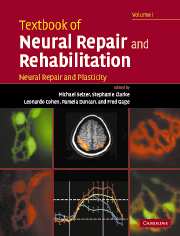Book contents
- Frontmatter
- Contents
- Contents (contents of Volume II)
- Preface
- Contributors (contributors of Volume I)
- Contributors (contributors of Volume II)
- Neural repair and rehabilitation: an introduction
- Section A Neural plasticity
- Section A1 Cellular and molecular mechanisms of neural plasticity
- Section A2 Functional plasticity in CNS system
- Section A3 Plasticity after injury to the CNS
- Section B1 Neural repair
- Section B2 Determinants of regeneration in the injured nervous system
- Section B3 Promotion of regeneration in the injured nervous system
- 25 Cell replacement in spinal cord injury
- 26 Dysfunction and recovery in demyelinated and dysmyelinated axons
- 27 Role of Schwann cells in peripheral nerve regeneration
- 28 Transplantation of Schwann cells and olfactory ensheathing cells to promote regeneration in the CNS
- 29 Trophic factor delivery by gene therapy
- 30 Assessment of sensorimotor function after spinal cord injury and repair
- Section B4 Translational research: application to human neural injury
- Index
27 - Role of Schwann cells in peripheral nerve regeneration
from Section B3 - Promotion of regeneration in the injured nervous system
Published online by Cambridge University Press: 05 March 2012
- Frontmatter
- Contents
- Contents (contents of Volume II)
- Preface
- Contributors (contributors of Volume I)
- Contributors (contributors of Volume II)
- Neural repair and rehabilitation: an introduction
- Section A Neural plasticity
- Section A1 Cellular and molecular mechanisms of neural plasticity
- Section A2 Functional plasticity in CNS system
- Section A3 Plasticity after injury to the CNS
- Section B1 Neural repair
- Section B2 Determinants of regeneration in the injured nervous system
- Section B3 Promotion of regeneration in the injured nervous system
- 25 Cell replacement in spinal cord injury
- 26 Dysfunction and recovery in demyelinated and dysmyelinated axons
- 27 Role of Schwann cells in peripheral nerve regeneration
- 28 Transplantation of Schwann cells and olfactory ensheathing cells to promote regeneration in the CNS
- 29 Trophic factor delivery by gene therapy
- 30 Assessment of sensorimotor function after spinal cord injury and repair
- Section B4 Translational research: application to human neural injury
- Index
Summary
Introduction
The objective of this review is to consider evidence that Schwann cells, the glial cells of the peripheral nervous system, play a crucial role in guiding and supporting the regeneration of peripheral axons. The presentation is biased by the author's own research perspective. It is certainly not encyclopedic and, for the inevitable slighting of important contributions, apologies are offered. The interest in peripheral nerve regeneration comes from its history, the substantial body of knowledge already obtained, and from its clinical import (see Volume II, Chapter 40). This interest is shown by the large number of reviews of the topic that have appeared, many in the last few years (cf. Hall, 1989; Fawcett and Keynes, 1990; Welcher et al., 1991; Bunge, 1993; 1994; Reynolds and Woolf, 1993; Brecknell and Fawcett, 1996; Ide, 1996; Scherer and Salzer, 1996; Fu and Gordon, 1997; Scherer, 1997; Taylor and Suter, 1997; Anderson et al., 1998; Frostick et al., 1998; Stoll and Muller, 1999; Terenghi, 1999; Hall, 2001; Jones et al., 2001; Fenrich and Gordon, 2004).
Schwann cells are derived embryologically from the neural crest (cf. Lobsiger et al., 2002). These cells associate with developing peripheral axons, migrate along these axons as they extend to their peripheral targets, and ultimately separate and wrap these axons (Peters and Muir, 1959; Lubinska, 1961; Speidel, 1964). Schwann cells provide two distinct types of axonal wrappings, one for larger axons that contains myelin and one for smaller axons that does not.
Keywords
- Type
- Chapter
- Information
- Textbook of Neural Repair and Rehabilitation , pp. 487 - 512Publisher: Cambridge University PressPrint publication year: 2006



